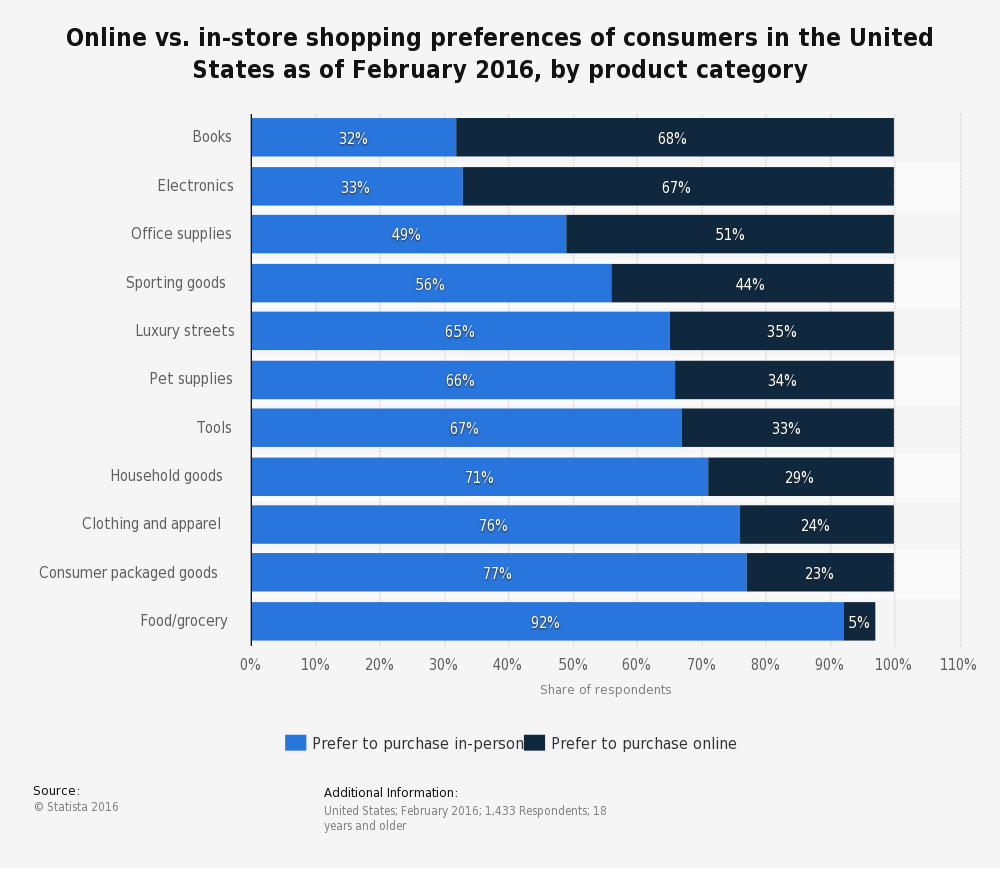Online grocery shopping trends in the United States from 2012 to 2021 and
statistics and facts on consumers’ online grocery shopping trends in the U.S.
This statistic highlights online grocery shopping sales in the United States in 2012 and provides an estimate until 2021. The U.S. online grocery market is estimated to generate sales worth of about 14.2 billion U.S. dollars in 2017, with sales forecast to reach 29.7 billion U.S. dollars by 2021. Among the leading online food and beverage retailers in 2016, were Amazon and Walmart.
Grocery sales through online platforms represent a very small part of the overall grocery retail market, but are amongst the fastest growing segment. Some people don’t enjoy the hassle of traditional grocery shopping, especially to stand in a queue before check-out. If consumers use the convenience of an online grocery service, they can pick their everyday products on the distributor’s website and will get the chosen items delivered right to their doorstep, which saves time. Most online suppliers in the United States provide same-day delivery options. During the last years, more and more firms tried to gain a foothold within the e-grocery industry. Companies engaged in the U.S. online grocery market include AmazonFresh, FreshDirect, NetGrocer, Walmart and Safeway.
A relatively new and innovative business model is supplied by Instacart. The San Francisco-based company is a grocery transport service that delivers the grocery order through personal shoppers in one to two hours. As of February 2015, Instacart charged 3.99 U.S. dollars per two-hour deliveries and 14.99 U.S. dollars per one-hour deliveries. The personal shoppers purchase the chosen items at different local food stores and deliver them to your house within the agreed time window.
The use of virtual grocery stores has still a large growth potential as more and more time-strapped consumers are looking for innovative ways to make their lives easier. However, a significant hurdle for online grocers remains freshness as many customers still prefer to see and touch the produce before purchase.
The vast majority of grocery shopping still takes place in traditional brick-and mortar stores. But according to industry experts, this pattern may change during the next decades. More and more tech-savvy retailers now offer grocery delivery options for their customers in the United States. Like the milk man used to do in the past, retailers bring food items right to your doorstep. As of 2016, some 5 percent of U.S. consumers preferred shopping for groceries online. In total, U.S. online grocery sales amounted to about 7 billion U.S. dollars in 2015 and are expected to rise to 18 billion U.S. dollars by 2020.
For time-strapped consumers online grocery shopping is a convenient and time-saving option. When shopping for groceries online, U.S. consumers visited about 2.2 different websites during their online shopping trip on average. About one third of consumers placed an order for groceries online about once a month in the United States in 2015. In the same year, the most popular e-grocery product categories included snacks, health and beauty care products and paper products such as paper towels or napkins in the U.S.
The emerging Generation Y, or so called Millennials, is known as a heavy internet user generation. They are characterized as open-minded customers when it comes to in-store apps or the usage of online grocery services. Keeping that in mind, it is not surprising that Millennial shoppers were the most likely to use online channels for grocery shopping in 2015.
According to online surveys conducted in 2013 and 2014, about 902 U.S. chief household shoppers were asked where they buy most of their groceries. In 2014, a significant majority – about 86 percent of U.S. consumers – named grocery stores/supermarkets as their primary shopping location for food.
The same question as above was asked to a larger set of consumers during a February 2016 survey, it was found that 92 percent of U.S. shoppers preferred to make general food/grocery purchases in person “in a store”. Only five percent of respondents preferred to shop for groceries online.

Online versus in-person shopping preferences of shoppers in the United States, sorted by product category (Source: Statista)
More information on this subject: INTERESTING FIGURES & FACTS ABOUT GROCERY SHOPPING

